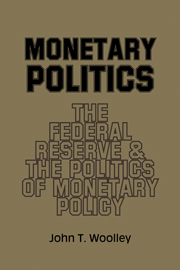Book contents
- Frontmatter
- Contents
- Preface
- 1 The Federal Reserve and the Politics of Monetary Policy: Introduction and Overview
- 2 A Capsule History of the Federal Reserve System
- 3 Recruitment and Selection of Federal Reserve Personnel
- 4 Bankers and the Federal Reserve
- 5 Economists and the Federal Reserve
- 6 The President and the Federal Reserve
- 7 Congress and the Federal Reserve
- 8 Making Monetary Policy in a Political Environment: The Election of 1972
- 9 Monetary Politics: A Summary
- Appendix A A Note on Data Sources
- Appendix B Legislation Included in Table 7.1
- Appendix C Academic Backgrounds and Career Experiences of Notable Monetarists
- Notes
- Bibliographic Note
- Index
7 - Congress and the Federal Reserve
Published online by Cambridge University Press: 01 June 2011
- Frontmatter
- Contents
- Preface
- 1 The Federal Reserve and the Politics of Monetary Policy: Introduction and Overview
- 2 A Capsule History of the Federal Reserve System
- 3 Recruitment and Selection of Federal Reserve Personnel
- 4 Bankers and the Federal Reserve
- 5 Economists and the Federal Reserve
- 6 The President and the Federal Reserve
- 7 Congress and the Federal Reserve
- 8 Making Monetary Policy in a Political Environment: The Election of 1972
- 9 Monetary Politics: A Summary
- Appendix A A Note on Data Sources
- Appendix B Legislation Included in Table 7.1
- Appendix C Academic Backgrounds and Career Experiences of Notable Monetarists
- Notes
- Bibliographic Note
- Index
Summary
In a formal sense, Congress is the Federal Reserve's superior. Members of Congress have jealously asserted their right to guide the System, and have occasionally aided the Federal Reserve in fending off administrations seeking a larger role in monetary policy. Members of Congress have repeatedly demanded a pledge from members of the Board of Governors that the Federal Reserve is responsible to Congress. In one exchange in the 1950s, Board Chairman William McChesney Martin was provided with a slip of paper reading “The Federal Reserve is an agency of Congress” and asked to tape it to his mirror so that he could see it each morning as he shaved.
In the early 1980s, the combined effects of high interest rates and high unemployment provoked considerable anger and concern in Congress. Many bills and resolutions were introduced to instruct the Federal Reserve about the conduct of policy. Some of those proposals were sponsored by influential members of Congress, including members of the leadership of both parties. If adopted, some of this legislation would have had the effect of completely removing the autonomy of the Federal Reserve and of substituting for it congressional determination of monetary policy objectives and, in some cases, operating procedures.
- Type
- Chapter
- Information
- Monetary PoliticsThe Federal Reserve and the Politics of Monetary Policy, pp. 131 - 153Publisher: Cambridge University PressPrint publication year: 1984
- 1
- Cited by



